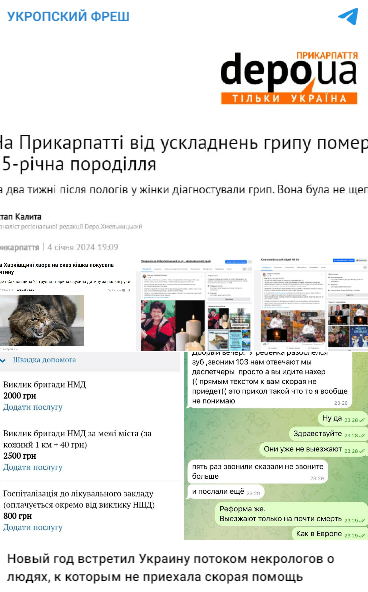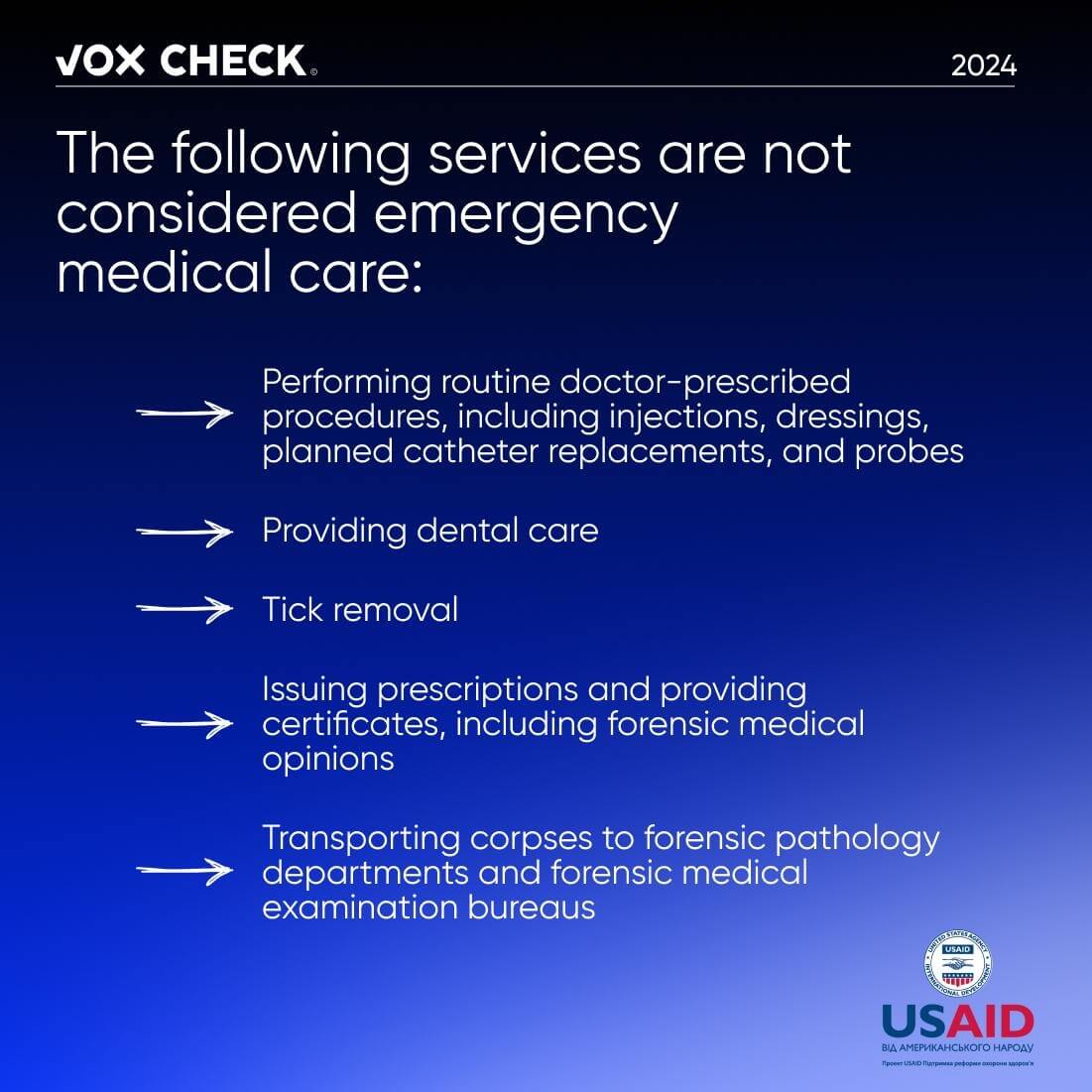Propagandists try to present fragments of individual news stories as a trend. Allegedly, due to a lack of ambulances, specialists are not responding to calls. People are dying because they did not receive timely assistance. The disappearance of vehicles is linked to the work of the Territorial Recruitment Centers. It is also noted that now calling a doctor is possible only for money.
With the support of the USAID Health Reform Support project, VoxCheck analyzes and refutes public health narratives spread in the information space of Ukraine, Belarus, and russia on a weekly basis.
Information is circulating online, claiming that Ukrainians are dying en masse due to the non-arrival of ambulances. Screenshots of news articles from Ukrainian media about people dying from “relatively harmless diseases” are provided. For example, in the Kharkiv region, a girl was bitten by a cat infected with rabies, but doctors did not administer injections to her; in the Carpathians, a girl died from the flu, and there are several cases where teachers and middle school educators experienced heart problems, and doctors simply did not come to them. A fragment of dialogue is also included, suggesting that an ambulance refused to arrive when a child had a toothache.
The absence of available ambulances is explained, in part, by the use of medical vehicles by Territorial Recruitment Centers employees for mobilization purposes. For example, a case in Odesa in December 2023 is mentioned. There are also alleged statements attributed to the head of the Volyn Medical Center, Volodymyr Shmal, claiming that in 2022 in Volyn region, “ambulances ran out, and later, doctors who were mobilized into the Armed Forces of Ukraine.”
All of this has purportedly led to the creation of corrupt schemes, where doctors are called only for money. For instance, in Kharkiv, reportedly there is a charge for emergency medical assistance. The local administration has increased the number of private clinics since medical facilities are overloaded with wounded Ukrainian soldiers. A call for emergency assistance costs 2000 UAH, transportation outside the city ranges from 1600 to 2500 UAH, and hospitalization to a clinic costs 800 UAH.
Screenshot of the post
What’s the reality?
The mentioned fatal cases do not indicate a problem with the functioning of the emergency assistance system. None of the news reports specify that death occurred due to the lack of proper assistance. Furthermore, in the news about a child bitten by an animal infected with rabies, there is no mention of the refusal to vaccinate the child.
The mentioned cases of the flu and rabies are not “relatively harmless diseases.” The flu is a highly contagious viral illness that can lead to complications and even death. Rabies is an acute infectious disease in animals and humans, caused by the neurotropic rabies virus. It is characterized by the development of specific encephalitis with rapid damage to the central nervous system. In case of delay in providing qualified medical assistance, death is inevitable.
Verifying the authenticity of the dialogue about calling an ambulance for a child with toothache is impossible. However, according to the rules for calling emergency medical teams, a team does not respond to patients for dental care. Therefore, in such a situation, the dispatcher had the right to refuse to dispatch an ambulance for the call.
In general, calls to emergency services are categorized as critical and urgent. Critical calls are considered in cases of absence or inefficiency of breathing, or massive blood loss/bleeding due to injury, external factors (electric shock, lightning, etc.), intoxication and poisoning, including animal bites, insect bites,and acute and chronic diseases.
Urgent calls include cases accompanied by: loss of consciousness; signs of bleeding; signs of acute coronary syndrome; signs of acute stroke; respiratory disorders, etc.
The response time norm for critical calls is 10 minutes from the moment the call is received by the dispatcher, and the call is accepted, while for urgent calls, it is 20 minutes.
There is no mass shortage of ambulances or their use as transport for the needs of the Territorial Recruitment Center. We have previously debunked the fake news about the absence of ambulances and doctors in the Volyn region due to mobilization. There have been no official reports of a shortage of ambulances being diverted for the needs of the Armed Forces; this information was fabricated by Telegram channels. The claim that all doctors in Volyn were mobilized was not reported by the Volyn Emergency Medical Center or other medical institutions in the region.
At the end of December in Odesa, a video was indeed filmed showing Territorial Recruitment Center employees allegedly trying to forcibly place a man in a medical vehicle, with a woman obstructing them. However, an official investigation revealed that Territorial Recruitment Center personnel were not involved in the events. Instead, a citizen asked her acquaintance, a serviceman from one of the brigades deployed in the east of Ukraine, to “scare” the man with “mobilization,” with whom she was separating and could not divide property. They used official special-purpose vehicles for this purpose. Currently, the vehicle has been returned to the brigade, where it is used for its intended purpose.
According to the market analysis tool YC.Market for the year 2023, 15 new private clinics opened in the Kharkiv region. The largest number of new medical institutions was recorded in Kyiv — 47 clinics. Local administrations have no relation to this, as they do not regulate the activities of private establishments. Services at the prices mentioned in the post are offered by only one of the private medical institutions. State services are provided free of charge. The Emergency Medical Care and Disaster Medicine Center in the Kharkiv region operates in a regular mode, regularly sharing the results of its work and receiving gratitude from patients on social media.
This information piece was produced with the assistance of the United States Agency for International Development (USAID), provided on behalf of the people of the United States of America. This article’s content, which does not necessarily reflect the views of USAID, the United States Government, is the sole responsibility of Deloitte Consulting under contract #72012118C00001.
Attention
The author doesn`t work for, consult to, own shares in or receive funding from any company or organization that would benefit from this article, and have no relevant affiliations




